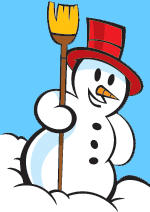

Ice Lake was the first game we published and, quite frankly, we made a pretty big mistake with the packaging. It didn't include any game information on the back. You couldn't pick up the game and tell what it was about. There was no picture, no information about how to play, none of that good stuff. This second edition gives the game all-new artwork and corrects all those problems.
The skaters are on dangerously thin ice. The ice can only support a skater's weight when it is connected to something. Once a skater is completely surrounded by cracks, that skater is standing on a free-floating piece of ice - making the skater more of a swimmer than a skater. So, once a skater is completely surrounded by cracks, that skater is out of the game.
A "crack" is a line drawn on the board. Any area surrounded by cracks is unstable and cannot be skated across. Even if that area does not include an entire hexagon, it cannot be skated across.
The easiest way to check if a skater is surrounded by cracks is this: use the back of a pen to try to draw an imaginary line from the skater to the shore. If you cannot do this without crossing a crack, then the skater is surrounded by cracks, and is out of the game.
When your skater is forced to stop, rotate the skate to face any direction you'd like. Do it at the moment that your skater is forced to stop. You'll find that you will almost certainly be able to move at the beginning of the next Movement Phase.
Two ways: You can't run into someone else (this isn't hockey), and you can't skate along a crack in the ice. You can skate across a crack, but not along it. Once you are forced to stop, rotate the skate, and then erase the rest of your plan - you don't move any more this round.
That's great - especially in party situations. Just take turns moving your skaters around the ice. This simplifies the game, but it's still quite playable. It's also a fun way to teach people how to play.
Yes...so do I. It's all part of the game.
Sometimes, you end up with a big hole in the middle of the ice and the players can't reach each other. If this happens, just move one skater to the edge of the bigger patch of ice on the start of the next round.
You could (in theory) have more than four people on the ice, but we found that the lake has to be significantly bigger. If we get enough requests for this, we'll see what we can do to make a bigger lake map.
The reason for the "ages 9 and up" on the game is that the pieces are small enough that a determined small child could choke on them. We don't want that happening.
By the way, I'm impressed with your 5 year old! Envisioning which way the skater will go (not to mention the whole left/right issue) is tough.
This is the tactic that everyone tries after playing the game the first time. The theory is that if you can turn the whole lake into one big hole, whoever is in the middle will get caught. However, it never works. Even if you don't skate off the ice by accident, the odds are high that one of your opponents will simply have turned left (or right) as their first or second move.
If you suspect your opponent of trying this (and you can tell by how long they take to write their first move), simply move either right or left after stepping on the lake. Because you can't skate along a crack that's already there, all you need to do is make one crack along the path your opponent is going to try to take.
The skater will have to stop at the point where your crack is. If you're clever, knowing this can let you easily win the game.